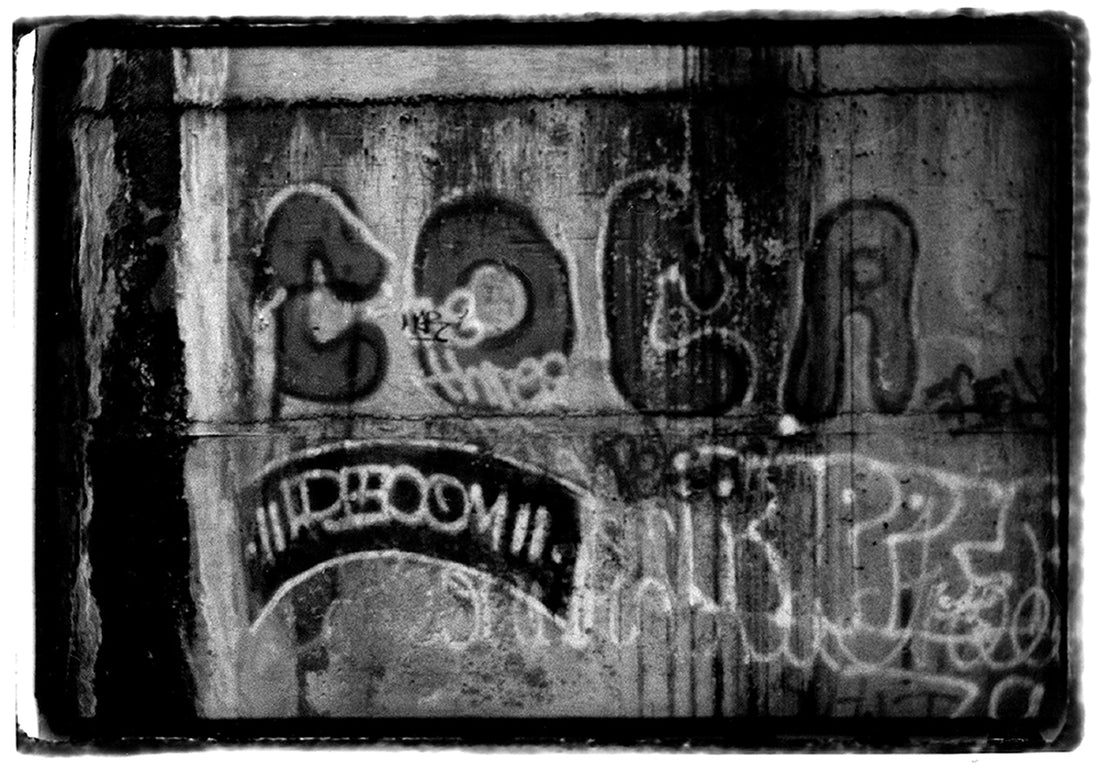From being in the middle of everything in New York to the meditative Huntington Beach, Pablo Calogero (a.k.a. COCA82) now has the Air to breathe. The jazz musician and former graffiti legend is featured on Writers on Wax: The Sound of Graffiti Volume 2.
There will probably never be any words (or any amount of words) that will do justice to the cultural impact New York City had in the world during the early 80s. Countless studies, documentaries, essays, films and series have been made to explain why New York was (and in some ways still remains) the epicenter of culture. But still, the story keeps evolving as time progresses.
Putting it bluntly, New York was a mess in the 80s. Coming out of virtual bankruptcy in 1977, New York was ridden with poverty, crime, dirt, energy crises, serial killers, crack cocaine, homelessness, slumlords, AIDS, and sex tourists. No one wanted to be in New York. Except for New Yorkers, probably against better judgement.
Going against better judgment sounds about as New York as it gets, and those New Yorkers that stayed saw a city in turmoil. They also saw a city rigorously trying to polish its public image (under the supervision of Ed Koch, followed by David Dinkins and Rudy Guliani), actively gentrifying neighborhoods and cleaning up the streets with Wall Street's not-so-hard-fought earnings. However, the youth has the future, and the youth in the city saw the city's decline as their chance to make it their own.
They were turning the city, lower Manhattan specifically, into one big playground, music venue and canvas. This was the era of pop art and street art. Of Haring, Basquiat, Warhol, The Velvet Underground and Fab 5 Freddy. New York was the place for disco, punk, hip-hop, and (later) house. And if it weren't born there, it would definitely end up there.
Born and raised in the middle of it, somewhere between Amsterdam Avenue and Broadway, Pablo Calogero saw it all happen. In fact, he was part of it, first, as a graffiti writer, part of the Soul Artist crew, and later as a producer, songwriter and saxophone player as an integral part of the American Latin jazz fabric.

J. Walter Negro & The Loose Jointz: Lennie Seely, Marc Edmonds (AKA J. Walter a.k.a. ALI), Tomas Donker, H.B. Bennet, Arturo O'Farrill, Pablo Calogero (a.k.a. COCA82) and Lonnie Hillyer. Photo taken after record deal with CBS REC, under John Hammond (record producer, visionary) Photo by Hank O'Neal
I spoke with Mr. Calogero via Zoom in late September, where he greeted me with a little saxophone riff amidst a cacophony of stuff in his house in Huntington Beach, CA.
Calogero is featured on Ruyzdael's latest release, Writers On Wax: The Sound of Graffiti Volume 2, along with seven of his (former) peers. Eight musicians who are also graffiti writers or eight graffiti writers who also produce music. Calogero's graffiti days are far behind him. He explains: "At some point, you gotta move on. And with all the shit that we experienced, that time had come in the early eighties."
The "we", in Mr Calogero's case, refers directly to graffiti royalty. Growing up in the Upper Westside (before it became the neighbourhood of stature and affluence it is now known for), Calogero went to school with legends of graffiti and street art mythology. Futura 2000, Zephyr, Ali, Dondi, Eric Haze and SAMO (yes, that guy who made those artworks on your Uniqlo t-shirt) were all in Calogero's inner circle. "Upper West Side was where it all happened," he explains. "While in Junior High School, we started seeing graffiti on the trains, made by the real old school guys such as Moses and Stay High. We came right underneath them, riding the 1 train to school every day and bombing it until there was no spot left to write on it."
Led by ALI (Marc Andre Edmonds), Calogero and his friends became a well-known crew named The Soul Artists. Calogero himself tagged his writing with "COCA82," referencing the street he lived on and the product he saw around him there. "It was a subject of conversation in the neighborhood," he cryptically elaborates. "You should know that it wasn't anything like the Upper West Side is now. My uncle lived in San Juan Hill before it was demolished to make space for Lincoln Center for the Performing Arts. I've played at the Lincoln Center (Calogero was part of the Lincoln Center Afro Latin Jazz Orchestra), but there was a very diverse and lively community that lived there before it."
San Juan Hill housed a predominantly black, Afro-Caribbean and Puerto Rican community filled with many live music clubs and a vibrant cultural scene. Calogero grew up just a few blocks from the Lincoln Center but in a completely different world from the tuxedoes and plush of the concert halls. "I was a street kid," he recalls. "It was the start of modern-day graffiti writing, and we would literally risk our lives to bomb a train. We would go to certain bodegas all the way up in the Bronx to get those big markers before we switched to spray cans, and it really went out of control. It was crazy. And crazy dangerous too."
Calogero and his friends from The Soul Artists were still in school when they made a name for themselves in New York as the infamous writers from the Upper West Side. However, his interest in graffiti started to vanish as his reputation rose. "You know, this was long before anyone considered what we did as being art," he says jokingly. "I just wasn't interested in the danger anymore. I realised that if I didn't want to end up like those crazy motherfuckers in the neighborhood, I had to evade them and stay in school as much as possible, which led me to music."

FUTURA, Lennie Seely, Louis Aterson, Pablo Calogero (a.k.a. COCA82), Marc Edmonds (a.k.a. J. Walter AKA ALI) live at the Peppermint lounge. Circa 1981
It wasn't just academics that made Calogero put down the cans, however. In 1973, friends ALI and Futura rang his doorbell at 3 AM to bomb trains at the yards, but a tragic accident would follow, that changed the lives of everyone involved. "They went to the tunnels above 135th Street," he recalls. "At night, you could do whatever you want and take time to make a big piece. ALI and Futura brought their stuff, but somehow it caught fire, causing a massive explosion that almost cost ALI his hands. For some reason, I didn't go, and who knows: maybe it saved my life."
The accident left more scars than just on ALI's hands. Both Futura and Calogero left graffiti for what it was. "I did leave a tag underneath ALI's bed in the hospital," he shamefully admits. "But that was a sign for me to pursue music further. I also just wanted to get out of the misery of the neighborhood. You could get robbed at any moment. Everywhere you looked around you, there were used needles on the floor. It was a terrible time. So I took school more seriously, practised the saxophone every day and auditioned for the Music and Art High School on 135th Street."
Calogero immediately got gigs while still in high school. He started making his own music and joined Latin jazz legend Tito Puente's band right after graduating. At that time, Calogero also started the infamous band Loose Jointz, who had a modest hit in Europe with the single Shoot The Pump. The band featured former Count Basie Orchestra member Dennis Mackrel and pianist Arturo O'Farrill (Blue Note recording artist and son of legendary conductor Chico O'Farrill). The band was (once again) led by ALI, who, for this occasion, chose the moniker of J. Walter Negro as a riff on the ad agency J. Walter Thompson. "J. Walter was not a musician," he says with a smile. "But he got us gigs and was a very good writer. He actually wasn't even part of the band, but he would scribble little lyrics to the music we made, and some of them stuck around. He actually got us our first gig at the Peppermint Lounge during Tropical Hot Dog Night. Pretty soon after that, shit took off."
Walter Negro & The Loose Jointz had record deals with CBS and toured all over Europe thanks to Shoot The Pump, which basically features J. Walter Negro rapping about playing with the fire hydrants on a hot summer day. They opened for acts such as The Talking Heads, Blondie and Kid Creole, pioneering (yet again) what would grow out to be the most dominant culture in the Western world today: hip-hop.
Calogero didn't just stick to hip-hop, though. After J. Walter Negro & The Loose Jointz quickly dissolved, Calogero went on to play with some of the greatest musicians in jazz. He played worldwide, including his hometown's iconic Village Vanguard and Birdland, where he was part of the resident band for over eight years. Over the span of five decades, Calogero's sound went from hi-hop to straight-ahead jazz and from Afro-Latin salsa to ambient soundscapes, the latter of which you can also hear on the newest Writers on Wax release. "I don't like to narrow myself down too much," he says. "But I guess you could say that my style is organic. I'm standing on the shoulders of great musicians before me. I can only take and draw from the well of American music. Bringing together influences from Africa, Europe and indigenous cultures all collectively gathered in the backbeat."
With New York and graffiti writing far away in the rearview mirror, Calogero now lives in Huntington Beach, just outside Los Angeles, where he still works on new material. With a slight remnant of what once was a New York accent, he says living in California has given him a "[...] completely new dimension." Calogero moved to California after working on the Arne Glimcher movie The Mambo Kings (1992), starring Antonio Banderas in his first English language role. Calogero was featured on the soundtrack as part of the Tito Puente Orchestra and had a small on-screen role as well.
About his move to California, Calogero says: "I got out of a very intense period. ALI died tragically in the desert, just outside of Tucson, AZ. My wife is from here, we had a kid, and then 9/11 happened. We probably got the last available moving truck and split to the West Coast after that. I'm happy here."
Featured on Writers on Wax: The Sound of Graffiti Volume 2 is the song Air, which he created earlier in 2022. An ambient soundscape to provide some meditative breathing room on the album. "Sometimes people have a lack of oxygen, which is really the only thing we need," he says about the song. "When I wrote this song, I wanted to give the world some air--a moment to breathe in a crazy world. That's why the energy of it is such. To me, it's like an antidote to what's going on."
From the creative chaos of late seventies New York to the airy, calm sunshine in California, Calogero's journey has been a wild ride gradually slowing down. One thing that's always been part of that ride is the music, with a saxophone securely strapped around his neck wherever he is. It's been his instrument of choice since the age of 14, and roughly five decades later, the creativity, stories and memories remain in the sound of his instrument.
Header photo credits: Matt Weber

